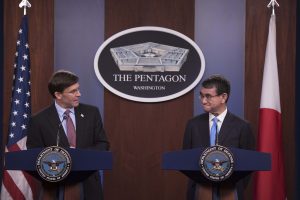U.S. Secretary of Defense Mark T. Esper is Pacific bound next week. He’ll be stopping by Hawaii, Palau, and the U.S. territory of Guam. The trip is being built around the 75th anniversary of the end of World War II in the Pacific, the Office of the Secretary of Defense said in a statement.
“On this trip he will conduct meetings with military leaders, local officials and foreign partners; visit with our forces deployed through the region; and participate in commemorative events marking the 75th Anniversary of the end of World War II,” an August 19 release noted.
It now appears that Esper’s trip may include a bilateral meeting with his Japanese counterpart, Taro Kono, in Guam. The two men last met in January 2020 and much has changed in the interim: not least because of the COVID-19 pandemic and its attendant effects on regional geopolitics and the U.S.-Japan alliance, but also the intensification of the debate in Tokyo on acquiring a strike capability and Kono’s decision to abandon plans to proceed with the procurement of two Aegis Ashore missile defense sites.
While the first reports of an Esper-Kono meeting emerged in Tokyo, the Guam Daily Post appears to provide corroboration. Lou Leon Guerrero, the governor of Guam, is cited by the Post as noting that “her staff are trying to set up a meeting.” The Kono-Esper one-on-one will reportedly take place at Andersen Air Force Base, a major U.S. Air Force facility in Guam.
The Kono-Esper meeting may offer one of the highest-level opportunities for consultation within the alliance before the U.S. election, which is now less than three months away. The two are likely to spend much time talking about developments pertaining to China and North Korea in the region. Additionally, Japan is likely to emphasize its continuing concern about incursions by Chinese vessels into the waters around the disputed Senkaku Islands.
Asia security watchers will, including this author, will be keeping a close eye on any indications that Esper might raise the issue of basing U.S. intermediate-range missiles in Japan. Earlier this month, Marshall Billingslea, U.S. President Donald J. Trump’s special presidential envoy on arms control, in an interview with the Nikkei Asian Review, indicated that American allies, including Japan, would benefit from the possible basing of missiles that the U.S. is now building, but was previously unable to possess due to the stipulations of the 1987 Intermediate-Range Nuclear Forces Treaty.
As far as I’m aware, while the Trump administration has indicated its interest in basing new conventional missiles in Asia, it has not opened formal consultations on the matter with any ally. Doing so with Japan months to go before the U.S. presidential elections and ahead of alliance talks on cost-sharing would be bold. Keep an eye on the Guam encounter next week.

































